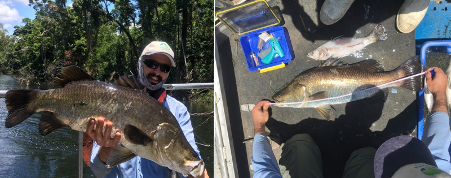Monitoring for the 2019 report card included an updated fish barrier indicator to better reflect the current health of our region’s estuaries. Using a combination of aerial imagery and field surveys, fisheries ecologists at Catchment Solutions catalogued and estimated the impact of fish barriers in regional estuaries, which translated into a fish barrier ‘grade’ for each estuary.
Fish barriers are structures that impede fish movement along a body of water. These structures can be natural or human-made, and are important to understanding the health of our waterways. Many fish species in the Mackay-Whitsunday-Isaac region, such as the iconic Barramundi, rely on freshwater basins and estuaries for migration as juveniles are particularly vulnerable to these barriers.
 How are fish barrier surveys conducted?
How are fish barrier surveys conducted?
Aerial imagery of the region is used to supply spatial data on where fish barriers are located. This information is then validated on the ground by fisheries ecologists at Catchment Solutions, who determine the effect that the barrier has on fish movement along the waterway. Using this and other metrics like stream size, number of barriers downstream, distance to the next barrier upstream, and proportion of intensive land use in the catchment, the Catchment Solutions team can assign a score representing the impact of fish barriers in a given waterway.
Why does this matter?
While the focus of this indicator is on impacted fish species, fish barriers tell us a great deal more about the broader health of our waterways. Many species play important ecosystem roles such as providing nutrient transport, building resilience within freshwater ecosystems and reducing the spread of invasive fish species. Freshwater fish species are also recognised as contributing significant societal values, and some species are recognized as important traditional foods for Traditional Owners.
Estuaries and basins play a key role in fish migration in the Mackay-Whitsunday-Isaac region. Many fish species in the Mackay-Whitsunday-Isaac region, such as the iconic Barramundi, are diadromous. This means that the fish spend their lives partly at sea and partly in freshwater. Diadromous fish are especially vulnerable to fish barriers, because juveniles may be required to migrate from the sea to upstream freshwater habitats to complete their life cycle.
By understanding the (literal) barriers that fish are facing in our region, we can get a clearer picture of the health of our waterways, and how we can manage these ecosystems effectively.
The 2019 report card is set to be released in July 2020, where updated fish barriers scores for the Mackay-Whitsunday-Isaac region will be showcased.




